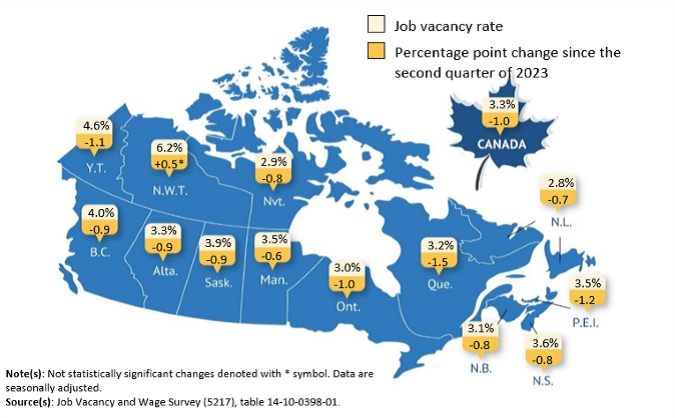Job vacancies in Canada fell for the eighth consecutive quarter, dropping by 59,000, or 9.2%, to 582,600 in the second quarter of 2024, according to new data released on Tuesday. This represents a steeper decline than the previous quarter’s decrease of 30,200, or 4.5%.
The fall in vacancies affected both permanent and temporary roles, with permanent positions down by 43,400 (8.3%) and temporary roles down by 15,600 (12.9%). Full-time and part-time positions also saw declines, with vacancies falling by 45,400 (9.5%) and 13,600 (8.3%), respectively.
Despite the drop in job openings, payroll employment rose by 62,000 (0.4%) in the same period, leaving overall labour demand—the combined total of filled and vacant positions — largely unchanged from both the previous quarter and the same quarter in 2023.
The job vacancy rate, which measures vacant positions as a proportion of total labour demand, dropped by 0.3 percentage points to 3.3% in the second quarter, the lowest rate recorded since the first quarter of 2020.
The labour market’s easing was further reflected in the unemployment-to-job vacancy ratio, which increased to 2.4 unemployed persons for every vacant job. This ratio has been rising steadily since the third quarter of 2022, driven by both a reduction in job openings and an increase in the number of unemployed individuals.
Job vacancies fall across multiple sectors
Seven of the 10 broad occupational categories saw a reduction in job vacancies. Trades, transport, and equipment operators and related occupations experienced the sharpest decline, with vacancies dropping by 19,200 (15.3%) to 105,900. Sales and service occupations followed closely, down by 18,400 (9.9%) to 168,400.
“Vacancies in trades, transport, and related sectors have been on a downward trend for eight consecutive quarters, a notable shift from the peak of 195,000 vacancies in the second quarter of 2022,” the report stated. Year-over-year, vacancies in this group were down 46,900, or 29%, with significant declines for roles such as transport truck drivers, construction trades helpers, and material handlers.
In the sales and service sector, which accounted for nearly 29% of all vacancies in the second quarter, the most significant reductions were in positions for food counter attendants and kitchen helpers, retail salespersons, and customer service representatives.
The health sector also saw a decline in job vacancies, with 3,900 fewer positions (4.3%), marking the first significant drop since 2022. However, health-related roles continued to represent a larger proportion of total vacancies compared to other sectors, rising to 15.2% of all open jobs.
Wage growth persists despite shrinking job market
Amid the shrinking job market, wages for vacant positions continued to grow. The average offered hourly wage for these roles rose by 6.8% year-over-year to $26.80 in the second quarter, compared to an increase of 7.3% in the previous quarter.
Full-time positions saw an average wage increase of 6.6%, while part-time roles experienced a higher growth rate of 7.7%. Positions requiring a high school diploma or lower levels of education accounted for the majority of the overall decline in vacancies, down by 140,900 (29.8%) compared to the same quarter in 2023.
Regional disparities
Geographically, job vacancies decreased in 25 of 69 economic regions. Quebec, Ontario, Alberta, and British Columbia were among the provinces most affected, with the largest regional declines seen in Toronto, Montérégie (Quebec), and the Lower Mainland-Southwest region of British Columbia. Conversely, job vacancies in Manitoba’s Southwest region saw a slight increase.

The report highlights continued challenges in filling positions across key sectors, though wage growth suggests some employers may be raising pay to attract talent in a competitive market.
Job vacancies continue to decrease in broad occupational groups in the second quarter, job vacancies (thousands)
| Occupational Group | Year-over-year Change (thousands) | Quarter-over-quarter Change (thousands) |
|---|---|---|
| Sales and service | -79.7 | -18.4 |
| Trades, transport and equipment operators and related occupations | -48.5 | -19.2 |
| Business, finance and administration | -15.3 | -4.6 |
| Manufacturing and utilities | -13.6 | -3.5 |
| Natural and applied sciences and related occupations | -12.4 | -4.5 |
| Education, law and social, community and government services | -10.6 | -3.7 |
| Natural resources, agriculture and related production occupations¹ | -5.3 | -1.0 |
| Health | -4.7 | -3.9 |
| Art, culture, recreation and sport¹ | -4.1 | -0.8 |
| Legislative and senior management² | 0.1 | -0.1 |



